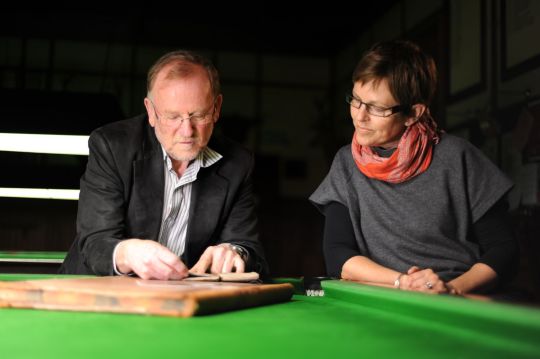
Several years ago the Wairarapa Archive was approached by Auckland film-maker Screentime for some background information for a documentary series about New Zealand disasters. It was to be titled ‘Descent from Disaster’ and was to be focussed on six significant New Zealand disasters, including plane and train crashes, ship wrecks, mine explosions, the 1931 Hawke’s Bay earthquake and the 1918 influenza epidemic. It was Wairarapa’s experience in the latter that they were interested.
Of the six disasters, the 1918 epidemic killed by far the greatest number. The epidemic, which seems to have originated in the United States in early 1918, spread around the globe. Estimates of the death vary wildly, but it seems that at least 25 million people lost their lives, far more World War One.
Director Bryn Evans was making the episode based on the influenza epidemic. He found that events in Wairarapa were representative of the epidemic, and discovered that Wairarapa Archive held records which would help his research. He talked to archivist Gareth Winter about events in Masterton and to Neil Frances about the effects of influenza at Featherston Military Camp. Eventually, having thoroughly searched the holdings of memories and photographs at Wairarapa Archive, Bryn came up with a filming schedule, concentrating on F.P. Welch’s work as a volunteer nurse, and the effects of the epidemic at Featherston Camp.
The film crew, with interviewer and narrator Judy Bailey, spent time at the Wairarapa Archive, perusing old records and newspapers, and then spent further time in the Masterton Club, looking at the plush surroundings that briefly served as an influenza hospital.
The first recorded cases of influenza in New Zealand were in Auckland in early October, although after the pandemic has passed, many people blaming the returning troopship Niagara which also carried the Prime Minister Massey. However, the ship docked in Auckland three days after three days after the first New Zealand deaths.
The first recorded outbreak in Wairarapa was at the Featherston Military Camp, where large groups of young men, statistically the most prone group, were assembled. In early November the local newspapers were stating that the flu had struck the camp and 299 men had been hospitalised. The camp housed thousands of soldiers in training and the disease spread very quickly. By the middle of the month over 2000 men were being treated in the hospital and 22 had already died. The first Masterton deaths were reported on the newspapers of 13 November. Mastertonians had gathered in the streets to celebrate the end of World War One, little realising that some of them were already infected with the disease. Some of the crowd collapsed at the ceremonies held in Masterton Park and were rushed to Masterton Hospital.
At the height of the Wairarapa pandemic the Masterton and Greytown hospitals were swamped with patients and nurses and doctors had contracted the disease meaning volunteer nurses and helpers were called for. Temporary hospitals were set up in many buildings through Wairarapa – in schools, clubs, and in the Masterton Borough Council Chambers. All schools were closed down until the following year and most businesses were instructed to remain shut.
Among those who were pressed into service as volunteer nurses was the local businessman F.P. Welch, who left a good record of Masterton during the epidemic in his dairy, now stored in the Wairarapa Archive. He writes of his many nights of service at the Masterton Club and the nearby Services Club, where he tried valiantly to help save the lives of those stricken with the flu. Ironically, Welch’s diaries, which span over forty years, usually record his own struggles with chest infections, but he somehow missed out on a dose of the 1918 influenza.
The film crew gained a valuable insight into the way the influenza epidemic affected a small but representative rural community and the country’s biggest military camp, while archive staff had a look at film-making – which seemed to require much sitting around and waiting but, for a day at least, was a novelty.




Recent Comments